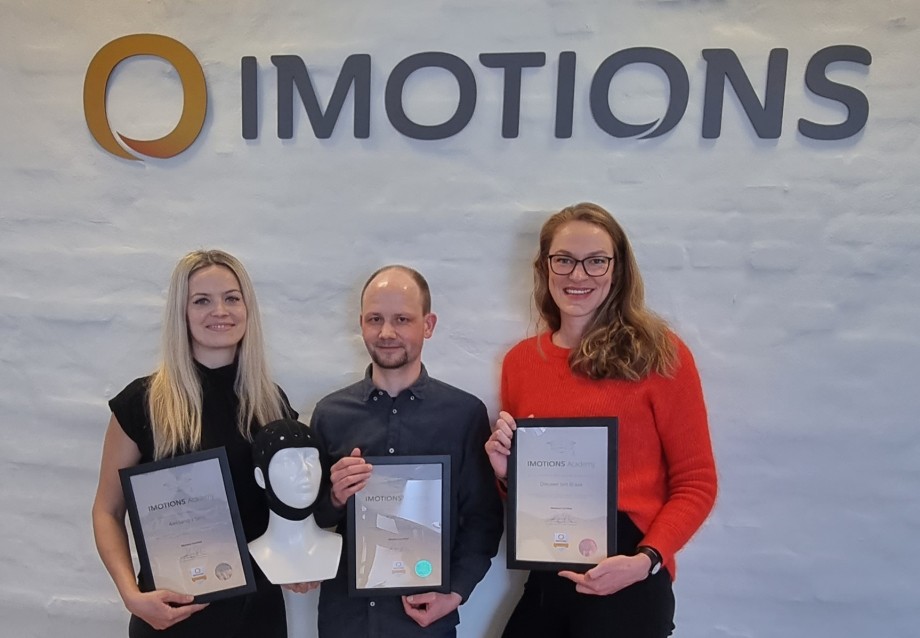PhD Candidate Aleksandra Sevic (Faculty of Health Sciences), chief engineer Kjetil André Eknes (Faculty of Science and Technology), and associate professor in psychology Dieuwer ten Braak (Centre for Learning Environment) attended a one-week course to learn how to use iMotions software to collect and analyze data from biosensors.

The course attendees included researchers from a variety of disciplines such as psychology, health science, architecture, kinesiology, and marketing, as well as product developers seeking ways to enhance their products.
“The course gave a nice overview of the possibilities of the iMotions software and how we can use the program to easily design experiments, collect data, and analyze results.”
What is iMotions?
iMotions is a software that integrates and synchronizes multiple biosensors, such as eye tracking, galvanic skin response, facial expression analysis, EEG, EMG, and ECG into a single application. The software is utilized by researchers across a range of disciplines, including healthcare, consumer insight, human factors, organizational psychology, and safety.
"During the course, an architect showed us a fascinating application of iMotions software. By linking biometric data directly to an architectural drawing program, she was able to design buildings with adaptive mobile features that respond to people's emotions. For example, a building might adjust its features based on the stress levels of its occupants, creating a more comfortable and supportive environment. It was inspiring to see how iMotions is enabling researchers in diverse fields to push the boundaries and come up with innovative solutions.”
What are the advantages of using iMotions?
Collecting and analyzing biometric data can seem daunting, especially without a background in signal processing and programming. However, iMotions software includes functions that automate much of this process. The program is nevertheless transparent and adaptable, allowing users to inspect and modify the underlying code. Additionally, users can connect scripts written in other programs, such as Python or E-Prime, to iMotions.
A challenge when collecting data from multiple sources in real-time is the integration and alignment of the input and the output data. The advantage of iMotions is that it allows collection and analyzing of data through a single platform that automatically synchronizes data input from all biosensors as well as behavioral responses, such as key presses or survey answers.
"During the course, we designed an experiment and collected real data from participants using surveys, cognitive tests, and multiple biosensors. The ease and speed with which we were able to collect and analyze biometric data using iMotions was impressive."
How do you intend to utilize iMotions software in your research?
Aleksandra, do you see possibilities to use iMotions in your PhD?
“Absolutely. In my research I focus on investigating the impact of increased use of digital technology (digital stressors) on individual health and cognitive processes. Typically, such research involves subjective measures, including self-report questionnaires, where participants are asked to report on their thoughts, feelings, and behaviors. However, relying solely on self-reported data may not always accurately capture subtle changes in personal experiences, as individuals may not always be aware or able to fully articulate their thoughts and feelings, leading to potential inaccuracies and biases.
To overcome these limitations, I am exploring the potential of using biosensors in my research. Biosensors can provide a more objective and accurate measure of physiological parameters associated with stress (such as heart rate variability) and cognitive performance (eye-tracking), thereby complementing self-report measures. Nevertheless, integrating data from multiple biosensors can be challenging. Here I see the potential of iMotions software, which allows the researcher to design a study, collect and integrate data from multiple biosensors in real-time, as well as perform some of the data analysis, all within the same software. By utilizing the iMotions software for data collection and analysis, I aim to hopefully simplify some of the technical aspects of the research process.”
Kjetil, you are an engineer connected to the Cognitive Lab. What do you think about the iMotions software? What are the advantages and are there any disadvantages?
"iMotions software is great when you need to use multiple sensors together and they need to be synchronized. The function to include surveys and design the stimuli presentation is also quite easy to set up compared to similar software. One downside may be that it is not always straightforward to set up sensors to make things work. iMotions could also improve their documentation and make it more easily accessible.”
As a cognitive and behavioral researcher, Dieuwer, what possibilities do you see for using iMotions software?
"I am interested in children's executive function and always looking for ways to better measure and understand their cognitive abilities. Traditional methods of assessing executive function using computer tasks can be limited - we often don't know if children are really engaging their executive functions or if external factors are influencing their performance. With iMotions’ ability to collect data from multiple biosensors, I can gain deeper insights into the underlying mechanisms that drive children's performance on executive function tasks. For example, eye-tracking, but also EEG, can provide data on whether children are focusing on the task and engaging their executive functions or not. This will help me to provide more accurate assessments of children’s abilities and better understand how to support their cognitive development.”